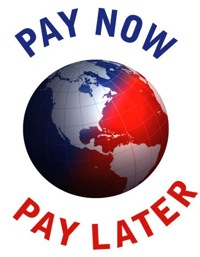
Pay Now, Pay Later: A State-by-State Assessment of the Costs of Climate Change
The American Security Project publishes telling reports on the economic costs of inaction on climate change for each state in the U.S.
WASHINGTON D.C. April 19, 2011 – Today the American Security Project released a series of 50 reports which analyze and project possible economic losses—or in some cases, gains—on a state-by-state basis as a result of unmitigated climate change. The project, “Pay Now, Pay Later” (PNPL), draws attention to the costs of inaction for each state if we fail to reduce greenhouse gas emissions.
Gov. Christine Todd Whitman (R-NJ), a former Administrator of the Environmental Protection Agency (EPA) and who serves on the Board of Directors at the American Security Project (ASP), said: “Too often the debate about climate breaks down over cost, with many Americans rightfully concerned about what limiting pollution would do to our economy. But what this series of reports shows is that there is a cost on the other side of the ledger, too. There will be costs to our economic security from climate change—and significant ones at that—if we do nothing but continue business as usual.”
Dr. Jim Ludes, Executive Director of ASP, said: “The costs of inaction on climate change will be steep for each state, as our reports outline. We’re looking at major costs to our economy, security, competitiveness, and public health. Kentucky’s timber industry, alone, generates $9.3 billion for its economy; Arkansas’ employs tens of thousands. Wooded lands will be damaged as a result of drier ecosystems, which are susceptible to harsher and more frequent forest fires. A warmer global climate and changes in precipitation could cost Kansas over $300 million and hundreds of jobs in crop losses by 2035.”
Lindsey Ross, Policy Analyst for Climate Security at ASP, added: “Severe storms and erosion threaten coastal communities, thus the warming and rising of sea levels could affect the 10 million plus people who live on Florida’s coast and other similar communities. Additionally, more severe storms and receding lake levels could disrupt shipping industries in states like Georgia, Ohio, and Michigan—a state that could suffer over $4 billion in import and export losses within the next several decades as a result of a decline in the Great Lakes system connectivity. In the US, we’ve already seen how a severe storm can economically devastate a region, its communities and businesses.”
In addition to tourism and agriculture, the defense industry does not go untouched by climate change. Military installations in areas vulnerable to extreme weather events have been impacted in past and are likely to be in the future. In 1992, Hurricane Andrew damaged Homestead Air Force Base in Florida to the point that it never reopened, and in 2004, Hurricane Ivan knocked out Naval Air Station Pensacola for a year (Source).
The PNPL reports show the costly, negative effects on our communities, our industries, and our jobs. The cost of inaction outweighs the cost of transforming our old energy economy into a green one. According to the Congressional Budget Office, a prominent cap-and-trade proposal would have cost $22 billion a year by 2020—a total of roughly $175 per US household. A small amount compared to the costs inaction will likely inflict. Moreover, one study finds investments in renewable energy—which requires less spending on machinery and imports—creates 3.5 more jobs per dollar spent than spending on the old energy economy (Source).
Ludes went on to say: “A lot of people can tell you the cost of proposals to address climate change, but nobody is talking about the cost of doing nothing to meet the climate change challenges we face in the United States. The findings in the Pay Now, Pay Later reports tell us that we can’t afford to continue business as usual. There are inevitable changes—short term and long term—in our environment that will have costly effects on our economies. We can either pay a little now to address it, or pay a lot more in the not-so-distant future.”
To read the state-by-state Pay Now, Pay Later reports and find out how much climate change is going to cost you, please click here






[…] a manner that tailors the discussion to specific geographic regions. ASP has for example provided a state-by-state breakdown of the economic costs of climate change, as well as a variety of materials detailing the […]
[…] report – “Pay Now, Pay Later” – draws attention to the costs of inaction for each state if we fail to reduce greenhouse […]
[…] Holland with the American Security Project noted that his organization released a state-by-state analysis of climate change and security implications in 2011 (including New York and New Jersey) titled […]
[…] To read ASP’s “Pay now, Pay later: A State-by-State Assessment of the Cost of Climate Change”, click here […]
[…] a figure that doesn’t even include potential damage from storms like Isabel or Ida. The American Security Project, a Washington think tank, projects that climate impacts could cost the state a whopping $45.4 […]
[…] American Security Project released a report in 2011, entitled, “Pay Now, Pay Later,” giving a state-by-state assessment of the potential costs of climate change. Our report on […]
[…] say that the $500 million raised will prevent such damage. As ASP’s 2011 report “Pay Now, Pay Later” found, it is almost always better to build resilience now, rather than paying the cost to […]
[…] is the essence of Pay Now/Pay Later—a research project we launched in my last year at the American Security Project. We examined […]